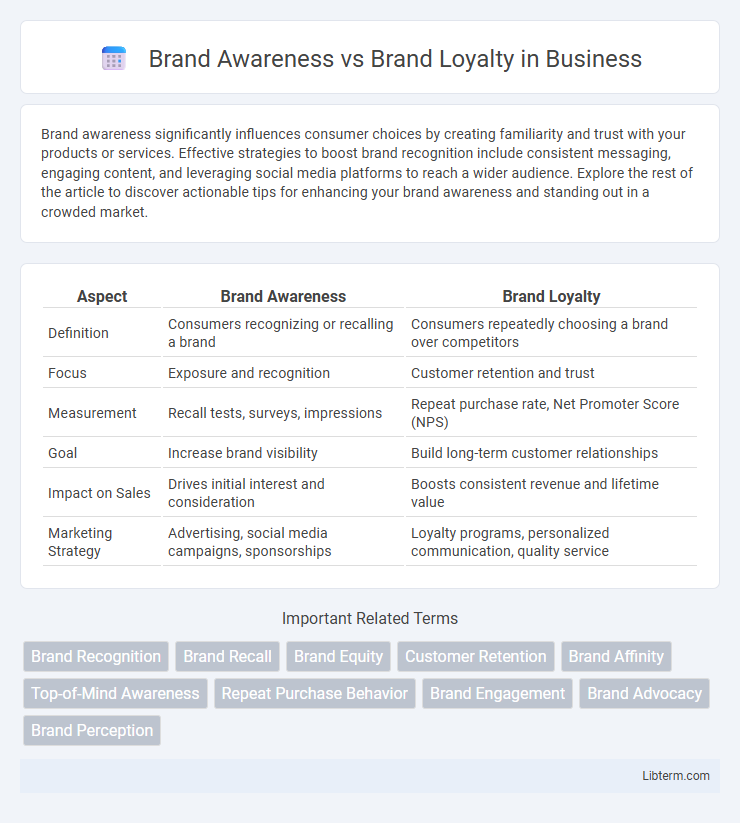Brand awareness significantly influences consumer choices by creating familiarity and trust with your products or services. Effective strategies to boost brand recognition include consistent messaging, engaging content, and leveraging social media platforms to reach a wider audience. Explore the rest of the article to discover actionable tips for enhancing your brand awareness and standing out in a crowded market.
Table of Comparison
| Aspect | Brand Awareness | Brand Loyalty |
|---|---|---|
| Definition | Consumers recognizing or recalling a brand | Consumers repeatedly choosing a brand over competitors |
| Focus | Exposure and recognition | Customer retention and trust |
| Measurement | Recall tests, surveys, impressions | Repeat purchase rate, Net Promoter Score (NPS) |
| Goal | Increase brand visibility | Build long-term customer relationships |
| Impact on Sales | Drives initial interest and consideration | Boosts consistent revenue and lifetime value |
| Marketing Strategy | Advertising, social media campaigns, sponsorships | Loyalty programs, personalized communication, quality service |
Understanding Brand Awareness
Brand awareness measures how well consumers recognize and recall a brand, forming the foundation for customer engagement and purchase decisions. High brand awareness increases the likelihood of brand choice during the decision-making process and boosts overall market presence. Effective strategies to improve brand awareness include consistent messaging, targeted advertising, and strong visual identity to create lasting impressions.
Defining Brand Loyalty
Brand loyalty refers to a consumer's consistent preference and commitment to repurchasing a specific brand over competitors, driven by positive past experiences and trust in product quality. It is measured by repeat purchase behavior, emotional attachment, and resistance to switching despite price changes or new alternatives. Strong brand loyalty increases customer lifetime value and reduces marketing costs by fostering long-term customer relationships.
Key Differences Between Brand Awareness and Brand Loyalty
Brand awareness measures how familiar consumers are with a brand's identity, logo, or products, serving as the initial step in the customer journey, while brand loyalty reflects a customer's consistent preference and repeat purchases of a brand over competitors. The primary difference lies in consumer behavior; brand awareness aims to increase recognition and recall across a broad audience, whereas brand loyalty focuses on deepening emotional connections and long-term retention among existing customers. Metrics for brand awareness include reach and impressions, whereas brand loyalty is tracked through repeat purchase rate, customer lifetime value (CLV), and net promoter score (NPS).
Importance of Building Brand Awareness
Building brand awareness is crucial as it establishes the initial connection between consumers and a company, increasing recognition and familiarity with products or services. High brand awareness enhances market presence, making it easier to attract new customers and support long-term growth. Developing strong awareness lays the foundation for brand loyalty, where customers repeatedly choose a brand based on trust and positive experiences.
The Value of Brand Loyalty in Business Growth
Brand loyalty significantly contributes to business growth by increasing customer retention and lifetime value, leading to consistent revenue streams. Loyal customers often provide free word-of-mouth marketing and reduce acquisition costs due to their repeated purchases and brand advocacy. Strong brand loyalty enhances competitive advantage, making the business more resilient to market fluctuations and price competition.
Strategies to Increase Brand Awareness
To increase brand awareness, businesses should leverage targeted social media campaigns, utilize influencer partnerships, and implement content marketing strategies that resonate with their audience's interests and needs. Consistent brand messaging across multiple platforms, combined with SEO optimization and engaging storytelling, enhances visibility and recall. Hosting events, offering promotions, and encouraging user-generated content also amplify reach and foster a stronger connection with potential customers.
Tactics to Foster Brand Loyalty
Effective tactics to foster brand loyalty include personalized customer experiences, loyalty programs with exclusive rewards, and consistent engagement through social media platforms. Brands that invest in high-quality products combined with exceptional customer service create emotional connections that drive repeat purchases and long-term loyalty. Utilizing data analytics to tailor marketing strategies and address customer needs enhances brand retention and builds trust over time.
Measuring Brand Awareness: Key Metrics
Measuring brand awareness involves key metrics such as aided and unaided brand recall, which assess how well consumers recognize a brand without prompts. Social media engagement rates and website traffic data provide quantitative insights into brand visibility and audience interaction. Brand awareness metrics help identify market reach effectiveness and guide strategies to enhance consumer recognition.
Tracking and Evaluating Brand Loyalty
Tracking brand loyalty involves measuring repeat purchase rates, customer retention metrics, and net promoter scores (NPS) to evaluate how consistently consumers choose a brand over competitors. Evaluating brand loyalty requires analyzing customer lifetime value (CLV) and engagement patterns through loyalty programs and feedback channels. Accurate tracking and evaluation enable businesses to refine strategies, enhance customer relationships, and increase long-term revenue.
Integrating Awareness and Loyalty for Long-Term Success
Integrating brand awareness and brand loyalty is crucial for long-term success, as awareness attracts potential customers while loyalty ensures repeat business and advocacy. Effective marketing strategies combine consistent brand messaging with personalized customer experiences to strengthen emotional connections and trust. Leveraging data analytics and customer feedback enables brands to fine-tune campaigns that boost both visibility and retention, creating a sustainable competitive advantage.
Brand Awareness Infographic

 libterm.com
libterm.com